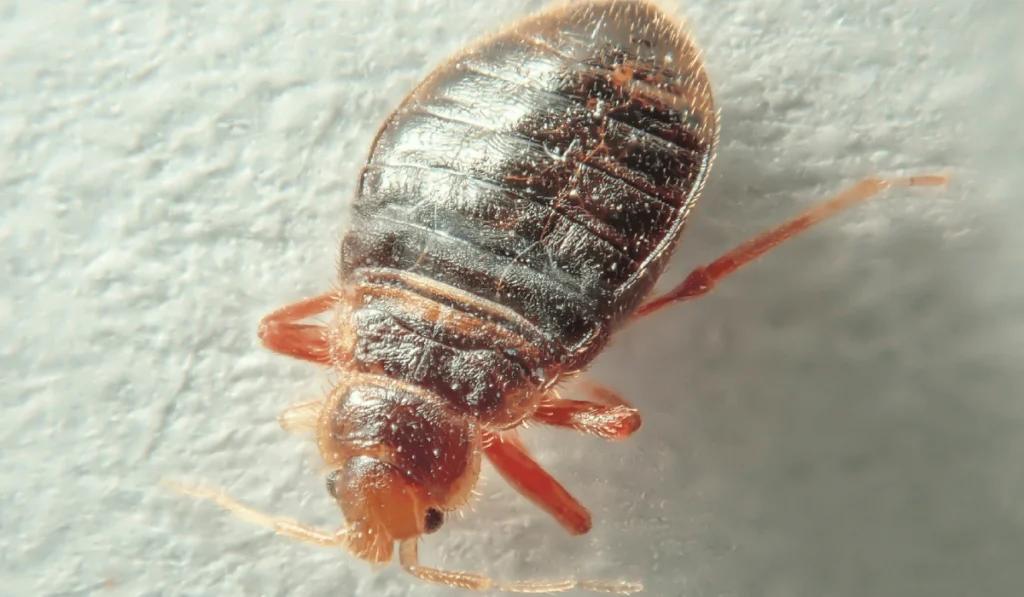Tips for Preventing Bed Bug Bites in Southern California
If you’ve noticed unexplained red welts or bites on your skin, these could be a sign that bed bugs are present in your living environment.
Bed bug infestations in California apartments and homes have raised concerns about the challenge of bed bug control and preventing bites to ensure a good night’s sleep.
So what can you do to prevent bed bug bites?
In this article, you’ll learn about different ways to prevent bed bug bites and products you can use as bed bug repellents.
Key Takeaways
- Products exist that can be applied to the skin to prevent bed bug bites.
- Validating the effectiveness and safety of these products is crucial.
- Utilizing skin repellents should complement broader bed bug control strategies.
– – –
🐜 Get bed bug control in Sacramento County or San Diego County
Bed bug infestations will not go away on their own
Contact Us Now To Get Rid Of Them
– – –
Understanding Bed Bugs

The common bed bug, scientifically known as Cimex lectularius, is a small, wingless insect that feeds on the blood of humans and animals.
Bed bug eggs are tiny, approximately 1 millimeter in size, and are translucent or pearly white. Typically laid in clusters, these eggs adhere to surfaces in cracks and crevices near potential feeding sites and contribute to the persistence and resilience of bed bug infestations.
A bed bug problem can also be difficult to eradicate due to the insects’ elusive nature, rapid reproduction, and resistance to many conventional pesticides.
Identifying Bed Bug Infestations
Bed bugs are sneaky bugs and their bites are often mistaken for flea bites. But if you’re sharp-eyed, you’ll spot signs of bed bugs.
Look for tiny reddish-brown insects about the size of an apple seed, especially in mattress seams, box springs, bed frames, and headboards. You can confirm infested areas by looking for small blood smears on bed sheets, upholstered furniture, or tiny black droppings often found near baseboards.
Adult bed bugs also shed their pale skins as they grow, finding exoskeletons or cast skins is another indicator of their presence.
If you’re a traveler, take precautions by inspecting hotel rooms and linens for signs of bed bugs and keep your luggage elevated to avoid catching bed bugs and bringing these pests home.
| Signs of Bed Bug Infestation | |
| Bed Bug Bites | Red, itchy welts often in lines or clusters on exposed skin. |
| Tiny Reddish-Brown Insects | Adult bed bugs are about the size of an apple seed, with a flat, oval shape. |
| Blood Stains | Small blood smears on bedding from bites or crushed bed bugs. |
| Dark Stains and Droppings | Tiny black or dark brown fecal spots on bedding or nearby furniture. |
| Eggshells and Empty Skins | Pale, empty exoskeletons and pearl-white eggs. |
| Musty Odor | Some report a sweet, musty smell in heavily infested areas |
| Live Bugs | Crawling on bedding, furniture, or walls in severe infestations. |
| Hiding Places | Check seams of mattresses, bed frames, headboards, and nearby furniture. |
Recognizing Bed Bug Bites
Bed bug bites can vary from person to person. These bites often appear as a line or cluster, looking like a reddish rash or welts.
While some individuals may not show any noticeable symptoms, others may experience allergic reactions and itchiness that can result in skin infection.
Bed bug bite symptoms
- Itching: Bed bug bites are often accompanied by intense itching, which can be persistent and bothersome.
- Redness: The bitten area typically becomes red and may appear as a raised, flat, or slightly swollen welt.
- Clustered Pattern: Bed bug bites may be grouped in a line or cluster, often in a linear or zigzag pattern.
- Bite Marks: The bites may leave small, red puncture marks, and in some cases, a central red spot may be present.
- Delayed Reactions: Some individuals may not immediately react to bed bug bites, and symptoms may appear hours or even days after being bitten.
- Secondary Infections: Scratching the itchy bites can break the skin and lead to the risk of secondary bacterial infections.
– – –
🐜 Get bed bug control in Sacramento County or San Diego County
Bed bug infestations will not go away on their own
Contact Us Now To Get Rid Of Them
– – –
First Aid for Bed Bug Bites
IMPORTANT: If you have strong or lasting symptoms from bed bug bites, or if you’re worried about how the bites look and heal, it makes sense to see your healthcare provider or a dermatologist. A doctor specializing in dermatology can give you advice and treatment for your bites.
At a Glance: Ways to Treat Bed Bug Bites
| Treatment Method | Description |
| Washing | Use soap and water for initial relief. |
| Topical Creams | Apply hydrocortisone or a stronger steroid cream for itching and inflammation. |
| Oral Antihistamines | Consider using oral antihistamines like Benadryl for persistent itching. |
| Essential Oils | Lavender, peppermint, tea tree, citrus, and eucalyptus may repel bed bugs. |
| Avoiding Certain Substances | Avoid using rubbing alcohol on bites to prevent skin irritation. |
| Professional Consultation | Consult a healthcare provider or dermatologist for persistent symptoms or concerns about the bite’s appearance and healing. |
When someone has bed bug bites, it’s essential to treat them without delay to prevent itching and potential skin infection.
A simple, yet effective first step is to wash the affected areas with soap and water to cleanse the bites and provide initial relief.
For ongoing treatment, home remedies like over-the-counter topical applications of hydrocortisone lotion or a stronger steroid cream may be recommended to control itching and inflammation. If itching persists, oral antihistamines like Benadryl can be taken to alleviate symptoms.
Essential oils are sometimes used as ingredients in bed bug repellents. Some essential oils are believed to have insect-repelling properties, and they are considered a more natural or alternative approach to bed bug control. Common essential oils used in bed bug repellents include:
- Lavender oil: Known for its pleasant scent, lavender oil is thought to have insect-repelling properties.
- Peppermint oil: The strong scent of peppermint oil is believed to be a deterrent for bed bugs.
- Tea tree oil: This oil is known for its antimicrobial properties and is sometimes used in bed bug-repellent formulations.
- Citrus oils (e.g., lemon, orange): Citrus oils are appreciated for their fresh scent and are thought to have insect-repelling qualities.
- Eucalyptus oil: Eucalyptus oil is another essential oil believed to have insect-repelling characteristics.
While rubbing alcohol (isopropyl alcohol) may be used for general disinfection purposes, it is not advisable to use it specifically for bed bug bite treatment. Applying rubbing alcohol directly to bed bug bites may cause skin irritation and dryness.
– – –
🐜 Get bed bug control in Sacramento County or San Diego County
Bed bug infestations will not go away on their own
Contact Us Now To Get Rid Of Them
– – –
Preventative Strategies Against Bed Bugs
To prevent bed bug infestations, ensure you regularly and thoroughly clean your living spaces. Pay attention to areas where bed bugs hide, such as seams, folds, and crevices in furniture and bedding.
Use protective measures like bed bug-proof mattresses and pillow encasements. Consider hiring professional pest control services for a comprehensive approach to identify, treat, and prevent bed bug infestations in your home.
Protective Bedding
Investing in bed bug-proof mattress covers is a solid first line of defense. These covers, often made from durable materials, are designed to encase the mattress and box spring, creating a barrier that bed bugs cannot penetrate. Ensure covers have strong zippers to prevent the entry or exit of these insects.
Regular Inspection and Cleaning
Regular inspection and cleaning of bedrooms can greatly assist in preventing bed bug infestations. Begin with the bed frame, sheets, and mattress, looking for signs of bed bugs like tiny reddish or brownish spots.
It’s essential not just to clean but also to vacuum furniture, cracks, and crevices frequently to remove any hidden bed bugs or eggs. Regular washing of bedding in hot water and high-heat drying can kill bed bugs that are already present.
Professional Pest Control Services
If you suspect that you have a bed bug infestation problem, consider hiring an exterminator or professional pest control services.
Bed bug infestations can be challenging to handle effectively, and DIY methods may not provide a comprehensive solution. Pest control professionals have the expertise, experience, and access to specialized treatments to identify, target, and eliminate bed bugs from your home.
An exterminator typically begins with a thorough inspection of all potential bed bug hiding places to assess the extent of the infestation. Based on the findings, the pest control company can then develop a customized bed bug treatment plan, employing a combination of insecticides, heat treatments, and other proven pest control methods.



